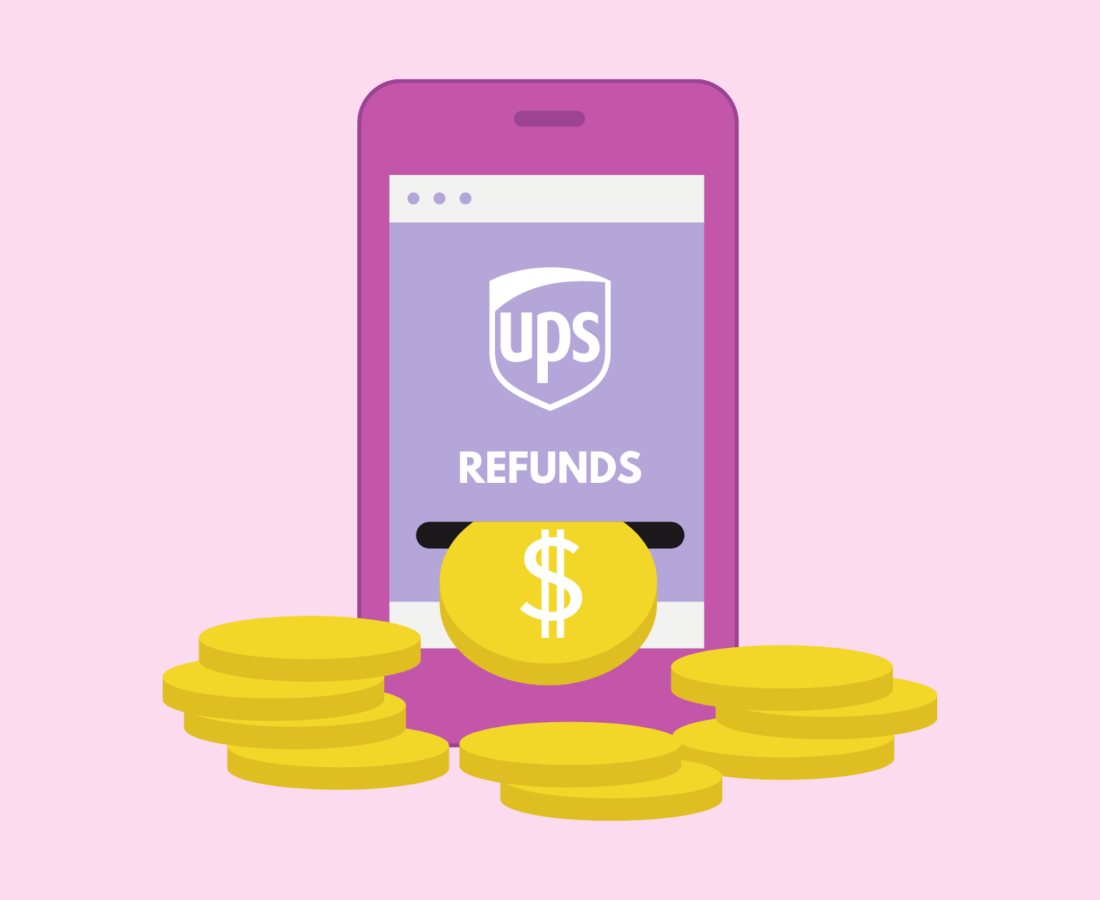Despite a massive fleet, state-of-the-art tracking systems, and delivery procedures, your customers’ parcels shipped through United Parcel Service (UPS) can be delayed, lost, or damaged in transit.
Behemoths such as UPS strive to provide an impeccable service every time. This is what leads them to provide a money-back guarantee for most services under their Service Guarantee.
Shippers who have faced service failures and billing errors at the hands of UPS can request a refund on their shipping costs. But before submitting UPS claims, here’s something to understand UPS’ Service Guarantee even better, so that we can get better at claiming UPS refunds.
Understanding UPS’ Service Guarantee and Refund Options
UPS’ Service Guarantee exists for orders that are delivered later than the scheduled delivery time/ date, then UPS owes the shipper a refund on the shipping cost. In simple terms, it is a ‘delivery will arrive on time or free’ guarantee made by UPS.
Service Guarantee (previously Guaranteed Service Refunds or GSR) is part of the shipping contract that stipulates that UPS will refund 100% of shipping charges if parcel delivery is delayed by even 60 seconds except in exceptional circumstances (natural disasters, weather delays, etc).
Things to keep in mind before filing UPS refund claims
Filing claims through UPS and getting refunds might look really straightforward but there can be occurrences where your refund claim may get rejected (not quality for a refund).
For instance,
- Not all UPS services (UPS SurePost, etc) are eligible for the Service Guarantee. Check if the shipment service you’ve opted for is eligible under Service Guarantee
- Your agreement with the carrier can prevent you from claiming credits. Make sure you haven’t signed a Service Guarantee waiver and given up your right to claim refunds
- The delivery issue has happened outside of UPS’s control (weather-related delays, customs issues, etc.)
- The shipment is sent around the holidays when there are peak season exclusions (UPS temporarily turns off Service Guarantee due to high shipping volume that strains their performance).
If you’ve ticked all these boxes and are sure that your shipment qualifies for a UPS refund, then let’s move on to how you can submit claims via UPS.
How to File UPS Claims for Service Failures
Filing refund claims is a step-by-step process that can be really easy if you’re familiar with the basics:
1.Prepare required information
Have all the necessary information ready that streamlines the start of this process. This includes gathering the following details such as tracking number, date of shipment, shipment weight, details of the package content, value of the goods (if filing for loss or damage), invoices or proof of the product’s value, etc,.
2. Initiate the claim
Once you have all the required information, you can proceed with the to file a claim.
- Go to the UPS site and choose “File a Claim” under the “Support Resources” section. You can also find one under the “Quick Links” tab in the homepage
- Log into your UPS account to file a claim (you can also file claims as a guest)
- Fill out the details requested such as tracking number, your status (shipper, receiver, third-party, etc)
- Select the reason for the claim — late delivery, lost package, etc
- Upload any documentation or other evidence to support your claim (photos, payment receipts, product descriptions, etc)
- Submit your claim
Or, you can also contact the number of UPS claims support at 1-800-PICK-UPS (1-800-742-5877) and say “Refund.”. Plus direct numbers are available for more load-specific claims.
3. Monitor your claim
After submitting, you can monitor the status of your claim in your UPS account under the Claims History section. UPS typically takes up to 10 business days to process claims and at this point, they may request additional information if necessary.
4. Receive your compensation
If your claim is approved, UPS will compensate you for the service failure by refunding the shipping costs.
While this looks relatively simple, however, it is not always the case. The process for manually filing UPS claims is a hassle to claim refunds, especially for businesses that ship frequently.
What Makes Manually Filing UPS Claims a Hassle
The problem with manually filing UPS claims is simply the conditions that come along in the Service Guarantee that make it intentionally hard to get successful refunds.
The Service Guarantee is filled with fine-print clauses that you have to strictly meet or else your claims can get rejected.
- First and foremost, check if you have signed a Service Guarantee waiver. This straightaway prevents you from claiming UPS refunds and is also not an efficient move.
- Wait 24 hours from the expected delivery time to claim refunds for lost packages. There are chances for your package to be delivered to you. However, you can straightaway submit refunds for late deliveries (for select services).
- Refund requests must be submitted within 15 calendar days of the scheduled delivery date or the date listed in the tracking details or your proof of delivery, whichever is later.
- In the case of lost packages (after ruling out incidents of misplaced packages in your garage with your neighbor or porch pirates) you have less than 60 days from the delivery date to file a claim.
- While manually filing refund claims, you have to make sure to enter the correct information such as the recipient’s name, address, date of shipment, package weight, tracking number, etc. Which can be tiresome and time-consuming.
- The claim process itself can sometimes take up to 10 days to be completed.
- The Service Guarantee does not apply to all services and destinations that UPS undertakes. Check for the validity of your claim!
- You need to submit all shipping documentation including labels according to “UPS’s Guide to Labeling”.
- In case of international shipments, you have to submit documentation required by the country of origin or destination to support your case.
- If the parcel involves a Saturday delivery route label, that must be included as well.
- The parcel must be tendered to UPS before the stipulated collection time. Check the timestamps to ensure that.
- If the parcel requires additional handling, you are not eligible for a refund.
That’s not all! Your UPS claim can still be rejected with finer-print terms and conditions.
The process of manually submitting UPS claims is doable IF you only ship a parcel or two a month.
But if your volume is something i.e just remotely more than that, you need A SOLUTION THAT CAN ACTUALLY SCALE!
It is not that carriers such as UPS do not have all the documentation for them to make the process efficient. They intentionally don’t make the claim process easy so it puts people off from claiming the refund money they are rightfully eligible for.
How to Successfully File UPS Claims
Many business owners do not realize that unclaimed UPS refunds are just money left on the table. This money runs to the tune of over 3 billion dollars annually. But what should matter more to you is this: Experts say that you can bring your shipping budget down by up to 20% if you claim every single refund you are eligible for.
Market leaders have their own processes in place to automate the refund process. But what does every other business do?
Most SMBs do not have the bandwidth or money to invest in an in-house team to handle refunds. This is where LateShipment.com has your solution.
If you were probably not aware of this before, we have an automated parcel audit and shipping refunds tool.
All you need to do is integrate this tool into your existing shipping operations while you focus on your core business functions.
How LateShipment.com Can Help You Claim UPS Refunds [and Save up to 20% of Your Shipping Costs]
LateShipment.com exists to help businesses like yours hold your shipping carrier accountable and ensure that you do not lose money that is rightfully yours.
Our parcel audit and shipping refunds solution automatically audits your shipping invoices and identifies 50+ carrier errors from UPS such as lost or damaged packages, incorrect surcharges, etc to ensure maximum refund recovery.
Also, by monitoring and claiming refunds regularly on your claims dashboard, you can ensure better performance from your shipping carrier and result in more successful last-mile deliveries.
Not just UPS, LateShipment.com also helps you file claims and recover refunds from all major carriers such as DHL, FedEx, Purolator, and Canada Post… to name a few.
The value we add to businesses is most evident when experienced first-hand.
Talk to our product experts today to get started with this incredibly simple way of recovering refunds for late deliveries, lost and damaged parcels, and more. Make UPS pay what is rightfully yours.
Frequently Asked Questions about UPS Refund Claims
1. Can I get a refund if UPS is late?
Yes, UPS promises on-time delivery for various service types including late, damaged, lost and 50 other. If your package is late by even 60 seconds you are eligible for a complete refund.
2. How long does it take to get a refund from UPS?
The UPS claim process might take an average of 10-15 days depending on the service error.
3. How do I file a claim with UPS?
Check out for manual claims here. To have an automated claim process Sign Up with LateShipment.com and automatically file refundclaims for eligible packages.
4. Why didn’t I get a refund for my UPS late package?
There are multiple reasons why you might not have received a refund for a late UPS package, that includes:
- Force majeure: The package gets delayed due to events beyond UPS’s control, such as weather or customs.
- Service type: The type of service used may not have been guaranteed, such as UPS SurePost.
- Shipping agreement: The shipping agreement (you signing a refund waiver) may have prevented you from claiming a refund, etc.
5. How can I make filing UPS refund claims easy?
Manually filing refund claims is always a hassle. To make things easy, it is best to make use of an automated parcel audit solution such as LateShipment.com that files claims on your behalf and also goes to the extent of depositing the refund money directly into your account.




